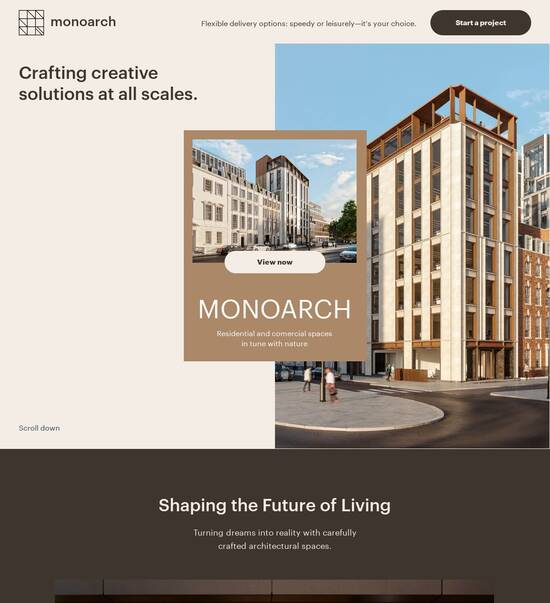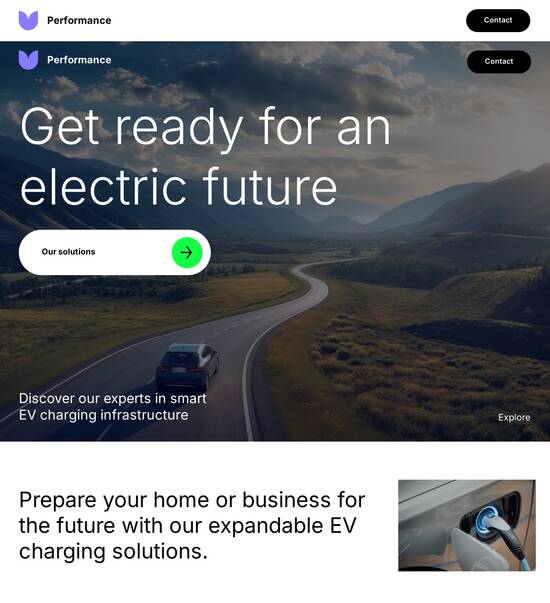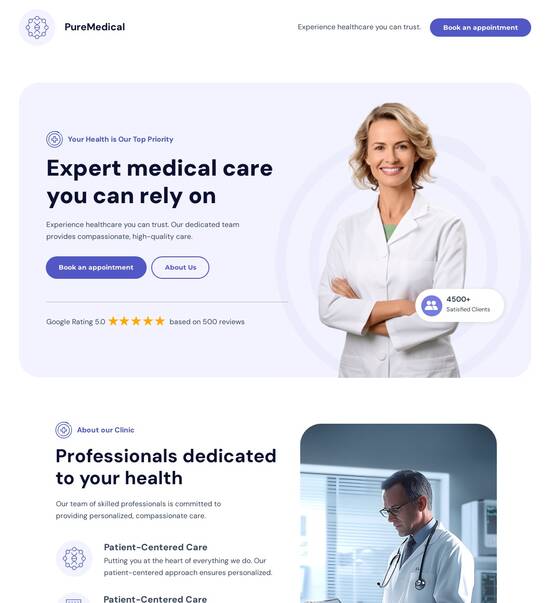
HTML page template for Pipeline engineers
Use TemplateAbout template
Attract clients and showcase your skills with style using our landing page templates for Pipeline engineers. Let's convert those visitors into clients!
Recommended templates

Easy to build without coding
With the intuitive drag-and-drop builder, anyone on your team can create high-converting pages without any knowledge of code or design. Make enhancements to your landing page with custom widgets using Javascript, HTML/CSS, or third-party scripts.

Multiple layouts for any industry and goal
Select from 500+ landing page layouts built to boost conversions across industry-specific scenarios. Customize them by adjusting fonts, adding images, and generating on-brand content with the AI assistant. Quickly scale with Instablocks® and Global Blocks that you can save, reuse, and update globally.

Loads fast and looks polished on any device
Every template is responsive, which means they present professionally on any device and load blazingly fast with our Thor Render Engine. You can also power them up with Google AMP technology to deliver an unparalleled mobile experience and drive higher conversions.

Robust analytics & experimentation
Get real-time updates and reporting across all your devices, showing the number of visitors, conversions, cost-per-visitor, and cost-per-lead. Launch AI-powered experiments, run A/B tests, and use heatmaps to analyze user behavior, then optimize your landing page to maximize conversions.







Easy to build without coding
With the intuitive drag-and-drop builder, anyone on your team can create high-converting pages without any knowledge of code or design. Make enhancements to your landing page with custom widgets using Javascript, HTML/CSS, or third-party scripts.
Multiple layouts for any industry and goal
Select from 500+ landing page layouts built to boost conversions across industry-specific scenarios. Customize them by adjusting fonts, adding images, and generating on-brand content with the AI assistant. Quickly scale with Instablocks® and Global Blocks that you can save, reuse, and update globally.
Loads fast and looks polished on any device
Every template is responsive, which means they present professionally on any device and load blazingly fast with our Thor Render Engine.
Robust analytics & experimentation
Get real-time updates and reporting across all your devices, showing the number of visitors, conversions, cost-per-visitor, and cost-per-lead. Launch AI-powered experiments, run A/B tests, and use heatmaps to analyze user behavior, then optimize your landing page to maximize conversions.
All the features you need to build lead-generating landing pages
Explore more featuresLearn how to build top-performing landing pages for any goal
FAQs
Leading the way in building high-performing landing pages





A comprehensive step-by-step guide to using Instapage for powerful landing pages
Creating high-converting landing pages is crucial for digital marketing success. Instapage offers an all-in-one landing page and CRO platform that empowers marketers in the USA, especially in sectors like business services and education, to accelerate their campaign effectiveness. This guide will walk you through the essential steps to maximize your ROI using Instapage.
Understanding the fundamentals of Instapage
Instapage is designed to elevate marketing efforts by providing a flexible platform where you can build and optimize landing pages without coding skills. The platform features intuitive tools that make it accessible for teams of any size, ensuring that your campaigns achieve their objectives efficiently.
Step 1: Choose the right template
Instapage offers over 100 high-converting templates tailored for various industry needs. To begin:
- Select a template that aligns with your campaign goals — whether for lead generation or product launches.
- Customize the template using Instablocks to add elements like forms and CTA buttons without needing design skills.
- Preview your landing page to ensure it aligns with your brand elements and messaging.
Step 2: Optimize for conversions
Optimization is key to improving user engagement and conversion rates. You can leverage built-in features to enhance your page:
- Use A/B testing to compare different versions of your landing page and analyze which performs better.
- Utilize heatmaps to study user behavior on the page, allowing you to make data-driven decisions.
- Monitor performance using analytics dashboards to identify areas for improvement.
Step 3: Personalize your audience experiences
Creating personalized experiences enhances engagement. With Instapage you can:
- Implement dynamic text replacement to customize headlines or offers based on user demographics.
- Use AdMaps to align specific ads with webpage content, ensuring relevancy.
- Track audience metrics to refine your strategies and enhance targeted marketing efforts.
Following these steps will help you leverage Instapage effectively, ensuring your landing pages are optimized for success.
Ready to transform your marketing campaigns? Start creating high-impact landing pages with Instapage today!
People also ask about HTML page template for Pipeline engineers
HTML page template for pipeline engineers
Understanding the HTML page template for pipeline engineers
The role of HTML page templates in pipeline engineering is to create a structured and consistent approach to documentation and project management. These templates provide a standardized format that engineers can utilize to maintain clarity and organization across multiple projects. As pipeline engineers often deal with complex data and intricate workflows, having custom templates is not just beneficial but essential for efficiency.
The importance of custom templates in engineering workflows
Custom templates serve as valuable tools in engineering settings, where project documentation must be consistent, accurate, and easily shareable. By defining the role of HTML templates, we can see their impact in streamlining repetitive tasks, such as report generation, data presentations, and compliance documentation. Templates reduce the time spent on formatting and the potential for errors, allowing engineers to focus on more critical project aspects.
The benefits of using HTML templates extend to improved collaboration as well. When all team members utilize the same templates, project documentation feels cohesive, which can significantly enhance team communication. Consistency across project documentation ensures clarity for all stakeholders involved.
Key features of an HTML page template tailored for pipeline engineers
An effective HTML page template for pipeline engineers encompasses several key features that support their specific workflows. For one, dynamic content management allows for customizability, enabling engineers to tailor templates for various project-specific requirements. This can include the use of variables and placeholders to facilitate streamlined updates as projects evolve.
Responsive design capabilities are equally essential. With more professionals using mobile and tablet devices, ensuring that your templates adapt across different screen sizes is critical. Developers can achieve this by employing CSS Flexbox or Grid systems combined with media queries to create layouts that flow seamlessly from desktop to mobile.
Furthermore, integration with popular technologies, such as JavaScript for interactivity and JSON for data handling, is invaluable. Real-world scenarios in engineering projects often require these integrations to enhance functionality, especially when dealing with large datasets or creating interactive visualizations.
Navigating the template framework: A deep dive
When constructing an engineering-focused HTML template, it’s vital to consider the essential components that form its backbone. A well-structured template includes the header, footer, and navigation menus, which help guide users through the document. Content sections are equally important for presenting data clearly and effectively.
Utilizing framework libraries such as Bootstrap or Foundation can greatly enhance the functionality and aesthetics of HTML templates. These frameworks offer pre-designed components, which makes it easier for engineers to create responsive layouts and maintain consistency across pages.
Engaging with communities and collectives: A resource for newbies
For pipeline engineers, exploring online platforms where they can share and access template resources is invaluable. Online forums and communities such as Stack Overflow or specialized engineering groups provide spaces for collaboration and feedback. These platforms are ideal for discovering templates that others have used successfully.
Additionally, popular platforms like GitHub host numerous template repositories where users can find pre-existing designs or contribute their custom versions. The community's role is crucial in fostering innovation, as feedback and collaboration on templates lead to improved resources and practices for all.
Collecting knowledge: Best practices for content creation
Organizing content relevant to pipeline engineering is vital for clarity and efficiency. Engineers should consider strategies that include structuring information logically and prioritizing readability. Using HTML elements such as headers, lists, and tables can enhance the presentation of information and make it easier for users to navigate.
Case studies within engineering projects reveal that effective content management often leads to successful outcomes. Teams that adopt a systematic approach to documentation regularly report faster comprehension rates and reduced misunderstandings during project phases.
Advanced features that enhance team collaboration
Templates not only standardize documents but also provide tools that enhance team collaboration. For instance, implementing version control systems allows team members to track changes and updates made within the templates, ensuring everyone is on the same page regarding project dependencies and decisions.
Preview features within template management tools facilitate iterative design feedback before final deployment. This allows team members to provide input and counsel on the design and functionality of the document. Such collaborative efforts lead to higher-quality outcomes as various perspectives are taken into account during the creation process.
Addressing common questions: FAQ section for users
New users often have several questions before embarking on their journey with HTML templates. What should they know before diving in? Key considerations include understanding how to integrate different technologies and being aware of potential pitfalls, such as forgetting to update variables or using outdated code.
Common pitfalls include neglecting proper structure and formatting, which can lead to poor readability. Adaptation of templates must occur to fit unique project requirements, and engineers should familiarize themselves with the flexible aspects of HTML coding to craft documents that meet their specific needs.
Exploring the format function and its benefits
The format function in HTML reflects how data can be reused across different projects or scenarios within pipeline engineering. By standardizing formats, updates and modifications become less cumbersome, facilitating a more efficient workflow as changes can be made site-wide rather than individually.
The benefits of implementing a standardized format extend beyond mere convenience. They significantly reduce the error margin and enhance the consistency of the information presented. Engineers can use standard formats to ensure that critical data, such as specifications and safety measures, always meets the established criteria.
Future of template use in pipeline engineering
The development of HTML templates in engineering is currently influenced by trends such as emerging technologies and the increasing need for automation. The evolving landscape suggests that future templates will integrate artificial intelligence to help design and optimize layouts according to project specifications automatically.
Predictions around the evolution of these templates hint at a more responsive build process, catering to the diverse needs of engineering disciplines. As technology continues to advance, engineers can look forward to more intuitive tools that simplify the design and documentation processes.
Reflecting on the transformational impact of HTML templates
Organizations that have adopted template-driven content creation report transformational impacts on their workflows. Increased productivity and efficiency have been met through the structured use of templates, allowing teams to focus on project fundamentals rather than mundane tasks.
Moreover, templates serve as a knowledge repository, fostering both retention and transfer of wisdom within teams. As engineers refine their documentation practices, the amassed knowledge becomes accessible to new team members, enhancing onboarding experiences.
Summary of essential insights on HTML templates for pipeline engineers
In summary, HTML templates serve as powerful tools for pipeline engineers, providing a framework for structured documentation and project management. Their extensive capabilities range from facilitating dynamic content management to enhancing team collaboration through standardized practices. By encouraging a culture of innovation and community involvement, engineers can elevate their documentation processes and ultimately improve project outcomes.
Ready to skyrocket conversions?
Supercharge your ad campaigns with high-performing landing pages
Get started














